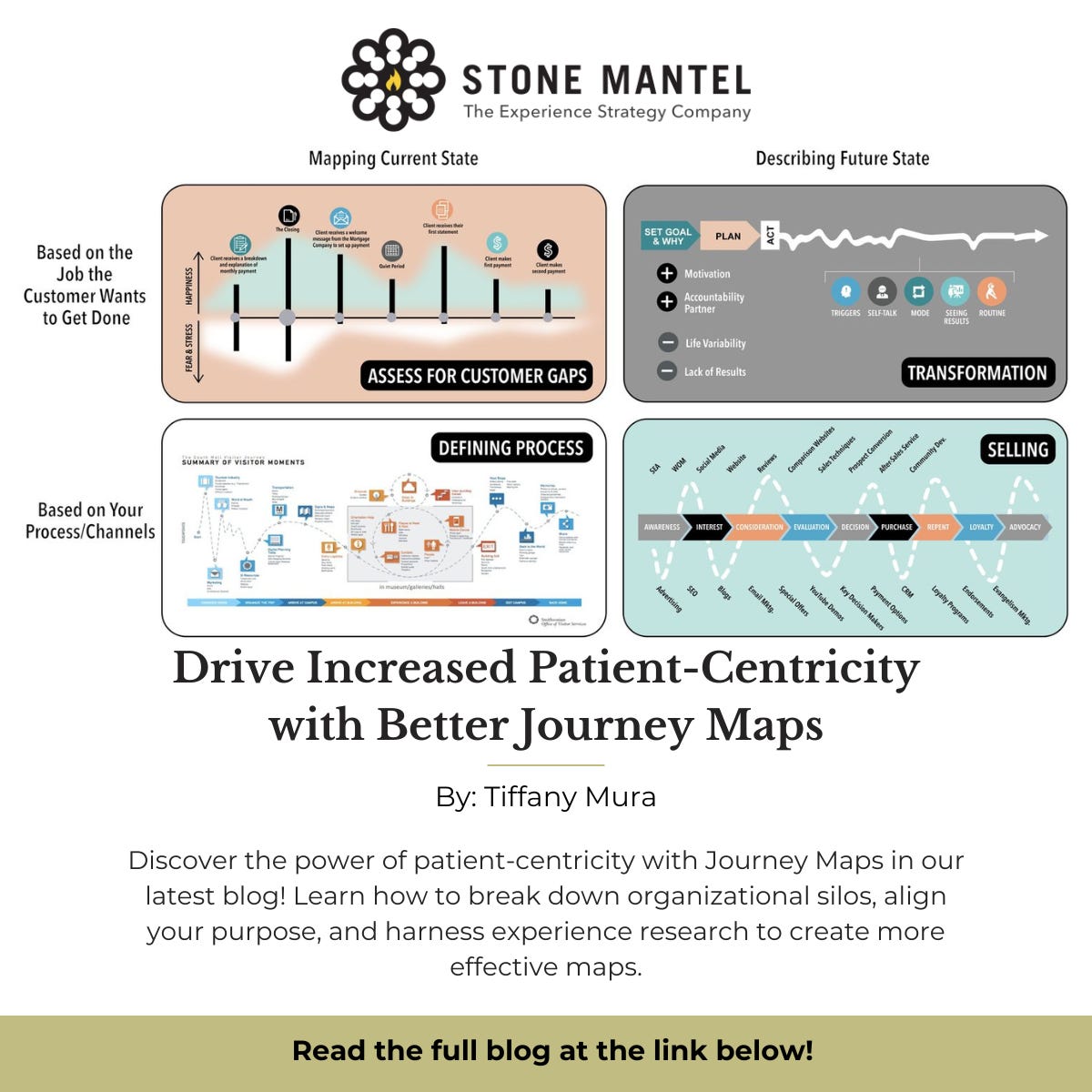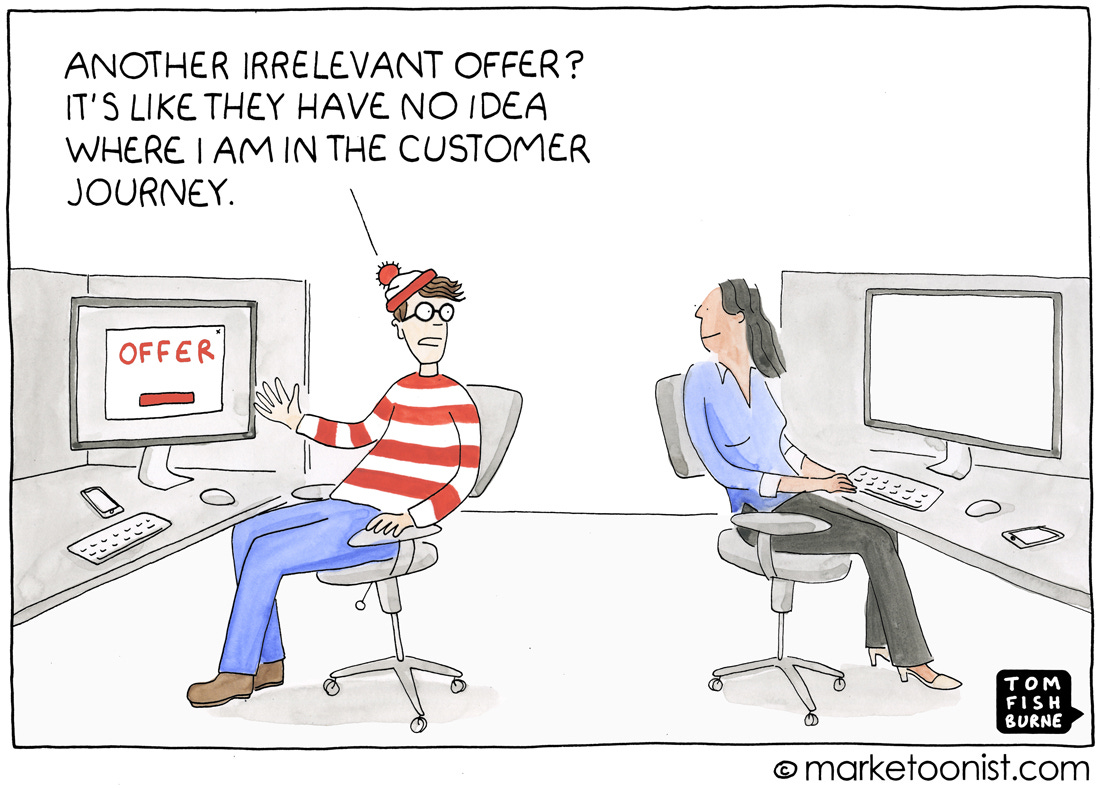Increasing Patient-Centricity with Journey Maps
A Comprehensive Guide to Transforming Healthcare Experiences
The Future is Bright for AI-Driven Patient Journey Maps
In just about every healthcare company today, there is a small group (or maybe a large group) of people tasked with developing the company’s point of view regarding AI. They are imagining what the future holds.
And they should be. Now is the time to strategize about AI.
Four years ago, Stone Mantel led a group of healthcare professionals from across the industry in a year-long Collaborative focused on AI and the patient journey. Now, remember, this is 2019-2020. ChatGPT had not yet surfaced.
But we knew that healthcare companies needed a point of view on AI back then, so that they could be prepared for what’s happening now.
As I write this, OpenAI has just announced a new speech-based interface for ChatGPT that will allow people to talk directly to the tool and receive answers or solutions verbally. Also today, Google launched world-wide its new generative AI ‘overviews.’ These overviews answer questions based on search.
So, when I say that healthcare companies needed a point of view on AI in 2019 to be ready for today, I mean it. If your company isn’t rapidly preparing for generative AI, you are already behind.
Here’s what generative AI means for healthcare journey mapping.
The complexity of the healthcare journey will now be navigated by the patient with assistance from their own personal assistant. Patients no longer depend on finding the right website, going to the right portal, or calling the right provider, they will ask their AI assistant to do the leg work and string together the steps they need to follow to get the car they need. Everything from directions on where to go to forms that need to be filled out. Oh, and definitely the questions that need to be asked. Instantly ready.
For chronic patients, their personal assistant will be independent of their providers, will gather the inputs shared by doctors and caregivers, and assemble a flexible plan for managing the well-being of the patient. Much of the work of creating and staying on a plan has been done piecemeal by the very separate role players in a patient’s experience. The AI will literally create an individualized journey map for the patient that detailed down to the dates that matter.
For acute patients, their personal assistant, will interface with providers, take in inputs, and provide the individual and family with specificity. Because the personal assistant knows the patient, it will be able to map specific steps for the individual and give timely advice to the individual to speed up diagnosis, treatment, and recovery.
How is a healthcare company supposed to respond to this new AI world?
The first thing to remember is that people don’t just want AI. They want humans who collaborate with and train AI. They want the AI to be powerful and the human to be empowered. As you seek to map the new patient experience, keep the human role front and center.
Second, remember that the patient is at the center of the journey. Not your process. The patient doesn’t move through your process as much as your process supports the patient. AI will eliminate unnecessary steps. Or at least flag them. Patients will only spend time doing the things that seem like time well spent. Your journey maps need to accommodate the specific needs of individuals, not turn everyone into the same type of patient.
Be prepared for AI to play a huge role in the patient journey. So much so that the AI will map the experience for individuals based on their needs and situations. That’s a good thing. It will eventually lead to less complexity for the patient and—who knows—maybe even the healthcare provider.
Attention healthcare experience leaders!
This insightful blog by
is a must-read guide on driving true patient-centricity through masterful journey mapping.Tiffany provides an actionable framework for breaking down organizational silos and fostering skilled cross-functional alignment around a unified vision of the optimal patient experience. Her expertise showcases how to harness deep consumer reach and behavioral insights to craft journey maps that accurately capture all the critical touchpoints, need-states, and micro-moments along the patient's journey.
By operationalizing these patient journey maps, healthcare organizations can redesign clinical and operational models to deliver more seamless, empathetic experiences that meet customers' fundamental needs and drive long-term loyalty. Don't miss this valuable perspective for transforming your patient experience and amplifying competitive advantage!
Drive Increased Patient-Centricity with Better Journey Maps
In today's evolving healthcare landscape, putting patients at the center of care is more important than ever. By focusing on patient-centricity, healthcare organizations can improve patient outcomes, satisfaction, and loyalty. Here are five key tips to help you enhance patient-centricity:
➡ Break down silos: Align journey mapping efforts across departments for a seamless patient experience.
➡ Define your purpose: Clearly identify if your map is for process definition, gap assessment, transformation guidance, or selling.
➡ Dive deeper with experience research: Go beyond market research to uncover patients' true "jobs to be done."
➡Leverage behavioral insights: Overlay a behavioral lens to pinpoint opportunities for driving positive change.
➡Embrace the experience map: Evolve your approach to incorporate post-pandemic expectations like digital-first interactions.
By implementing these strategies, your healthcare organization can create a more patient-centric approach that prioritizes the needs and preferences of those you serve.
When this innovative healthcare company Healthfully partnered with Experience Strategy Experts, they faced a critical challenge: to develop a digital strategy that would transform the healthcare experience and help them become a total care enterprise to advance the physical, social., and economic health of Northeast Florida communities 24/7/365.
Through a collaborative process involving Stone Mantel's POV, research insights, and the right Tech partner, they delivered the Virtual Health Village of the Future - an all-in-one, easy-to-use tool that eliminates friction across the healthcare continuum.
By leveraging research from The Collaboratives, Healthfully created an engaging, singular space where providers see patients virtually via kiosks in grocery stores and schools, while Flagler Health+ supports the community. The results, were game-changing, putting patients at the center of care and achieving the overall goal of transforming healthcare experiences and improving engagement with health.
Learn more about how The Collaboratives can help you increase patient-centric care at the link below.
Unlock the power of journey maps to drive patient centricity!
Read the blow to learn 3 essential steps to create effective journey maps that foster collaboration, align stakeholders, and uncover patients' core needs.
Read the full article at the link below to learn how you can revolutionize your approach to patient journey mapping and deliver exceptional experiences.
#ExperienceStrategy #PatientCentricity #JourneyMapping
Check out this comprehensive guide from Qualtrics on patient journey mapping as an invaluable resource for healthcare organizations seeking to enhance patient retention and satisfaction.
By examining the five critical stages of the patient journey and mapping out every touchpoint, healthcare providers can identify pivotal moments that significantly influence patient loyalty and uncover opportunities for improvement. This holistic approach transcends clinical care, encompassing all patient interactions with the organization, from initial online discovery to post-treatment billing and continuity of care.
Is your organization guilty of making offers that completely miss the mark? 🎯 Many companies launch initiatives without truly understanding where the customer is in their journey, leading to irrelevant and poorly timed offers.
At Stone Mantel, we help you map the customer journey from end-to-end, so you can deliver the right message at the right moment. Our collaborative approach uncovers key insights about your customers' mindset, motivations and behaviors at each touchpoint.
Ready to leave irrelevant offers behind and start speaking your customer's language? Let's connect to discuss how journey mapping can revolutionize your customer engagement strategy!
Send us a message below!
Want to take your healthcare organization's patient-centricity to the next level? The answer lies in leveraging the power of behavioral insights in your journey mapping efforts.
By incorporating a behavioral lens, you can uncover the deeper motivations, decision-making processes, and contextual factors that shape patients' experiences and outcomes. This enables you to design personalized, empathetic, and profoundly resonant solutions.
Dive into the fascinating world of behavioral insights and journey mapping in our blog post. Discover practical tips and real-world examples to inspire your own initiatives and create meaningful, lasting impact for your patients and organization.
Read now at the link below and begin your journey towards unparalleled patient-centricity!
#PatientCentricity #JourneyMapping #BehavioralInsights









